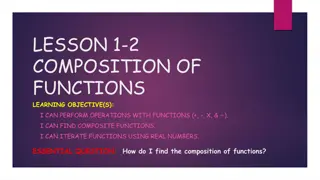Functional Programming Concepts for COMPSCI 220 Programming Methodology
In this tutorial, we explore functional programming concepts in the context of COMPSCI 220 Programming Methodology. We delve into writing functions using `reduce` and discuss examples and implementations of various functions like sum, product, and string length calculation. We also analyze the differences between functions and showcase the practical usage of `reduce` in functional programming.
Download Presentation

Please find below an Image/Link to download the presentation.
The content on the website is provided AS IS for your information and personal use only. It may not be sold, licensed, or shared on other websites without obtaining consent from the author.If you encounter any issues during the download, it is possible that the publisher has removed the file from their server.
You are allowed to download the files provided on this website for personal or commercial use, subject to the condition that they are used lawfully. All files are the property of their respective owners.
The content on the website is provided AS IS for your information and personal use only. It may not be sold, licensed, or shared on other websites without obtaining consent from the author.
E N D
Presentation Transcript
COMPSCI 220 Programming Methodology
1. We present three functions that cannot be written using map. 2. We derive the reduce function. 3. We draw reduce. 4. We derive the type of reduce. 5. We present several examples of reduce (counting odd and even numbers, partitioning an array into odd and even numbers, calculating statistics of an array). 6. We present the built-in reduce function. 7. We write map and filter using reduce The reduce function
Three different functions Problem Statement: Write a function that consumes an array of numbers and produces the sum of all the elements in the array. Problem Statement: Write a function that consumes an array of numbers and produces the product of all the elements of the array. Problem Statement: Write a function that consumes an array of strings and produces a the sum of the lengths of all the strings in the input array. Example: sum([3, 20, 100]) // 123 Example: prod([2, 3, 4]) // 48 Example: lenAll([ 'compsci', '220']); // 10 Type Signature: lenAll( a: string[]): number Type Signature: sum( a: number[]): number Type Signature: prod( a: number[]): number Solution: function sum(a) { let result = 0; for (let i = 0; i < a.length; ++i) { result = result + a[i]; } return result; } Solution: function prod(a) { let result = 1; for (let i = 0; i < a.length; ++i) { result = result * a[i]; } return result; } Solution: function lenAll(a) { let result = 0; for (let i = 0; i < a.length; ++i) { result = result + a[i].length; } return result; } Can we use map to write these functions?
Ignore lenAll for a moment. Deriving a new higher-order function Step 1: Identify the differences between sum and prod. Step 2: Abstract out the differences. Step 3: Make the differences an argument. function sum(a) { let result = 0; for (let i = 0; i < a.length; ++i) { result = result + a[i]; } return result; } let sumInit = 0; function sumF(r, x) { return r + x; } function sum(a) { let result = sumInit; for (let i = 0; i < a.length; ++i) { result = sumF(result, a[i]); } return result; } function reduce(init, f, a) { let result = init; for (let i = 0; i < a.length; ++i) { result = f(result, a[i]); } return result; } function prod(a) { let result = 1; for (let i = 0; i < a.length; ++i) { result = result * a[i]; } return result; } function sum(a) { return reduce(0, function(r, x) { return r + x; }, a); } let prodInit = 1; function prodF(r, x) { return r * x; } function prod(a) { let result = prodInit; for (let i = 0; i < a.length; ++i) { result = prodF(result, a[i]); } return result; } function prod(a) { return reduce(1, function(r, x) { return r * x; }, a); } Note: There are two differences between these functions. In contrast, when we derived map earlier, there was only one difference between the functions. Note: The code above uses anonymous functions for compactness. Note: The only difference is the name of the variable they refer to.
The reduce function, pictorially reduce(init, f, a) a: init
What is the type of reduce? 1. The argument f is a function that takes two arguments. The argument a is an array. The arrows indicate which types must be the same. // reduce(init: ___, f: (___, ___) => ___, a: ___[]): ___ function reduce(init, f, a) { let result = init; for (let i = 0; i < a.length; ++i) { result = f(result, a[i]); } return result; } // reduce<A, B>(init: A, f: (A, B) => A, a: B[]): A 2. 3.
More reduce examples Write lenAll using reduce. Problem Statement: Write a function that consumes an array of numbers and produces the number of odd and even numbers in the array. // lenAll(a: string[]): number function lenAll(a) { let result = 0; for (let i = 0; i < a.length; ++i) { result = result + a[i].length; } return result; } Example: countOddEven([1, 2, 3]) // { odd: 2, even: 1 } Type Signature: countOddEven(a: number[]): { odd: number, even: number } Solution: // combine(r: { odd: number, even: number }, // x: number): { odd: number, even: number } function combine(r, x) { if (x % 2 === 0) { return { odd: r.odd, even: r.even + 1 }; } else { return { odd: r.odd + 1, even: r.even }; } Two questions: 1. What is the initial value? 2. What is the combining function? // combine(r: number, x: string): number function combine(r, x) { return r + x.length; } function countOddEven(a) { return reduce({ odd: 0, even: 0 }, f, a); } // lenAll(a: string[]): number function lenAll(a) { return reduce(0, combine, a); } Notice that the types do not have to be the same!
More reduce examples Problem Statement: Write a function that consumes an array of numbers and produces two arrays of odd and even numbers from the input array.the number of odd and even numbers in the array. Example: sepOddEven([1, 2, 3]) // { odd: [1, 3], even: [2] } Type Signature: sepOddEven(a: number[]): { odd: number[], even: number[] } Solution: // combine(r: { odd: number[], even: number[] }, // x: number): { odd: number[], even: number[] } function combine(r, x) { if (x % 2 === 0) { r.evens.push(x); return r; } else { r.odds.push(x); return r; } } function sepOddEven(a) { return reduce({ odd: [], even: [] }, combine, a); }
More reduce examples Problem Statement: Write a function that consumes an array of numbers and the number of elements, the maximum, minimum, and mean. Example: stats([0, 1, 2, 3, 4, 5, 6, -9.95] // { mean: 1.38125, max: 6, min, -9.95, n: 8 } Type Signature: stats(a: number[]): { mean: number, max: number, min: number, n: number } Solution: There is a simple solution that involves calling reduce several times. There is an uglier solution that only calls reduce once. In this class, we favor simple solutions, even if they are less efficient. But, it is a good exercise to try to solve this with just one call to reduce. function stats(a) { if (a.length < 1) { // These statistics don't have any meaning for an empty list. assert(false); } let init = { mean: 0, max: a[0], min: a[0], n: 0 }; return reduce(init, function(r, x) { return { min: Math.min(r.min, x), max: Math.max(r.max, x), mean: (r.mean * r.n + x) / (r.n + 1); n: r.n + 1 }; }, init); }
The builtin .reduce method // sum(a: number[]): number function sum(a) { function f(r, x) { return r + x; } return a.reduce(f, 0); } Do not use the currentIndex and array arguments. Always provide an initial value.
Using reduce to write map Problem Statement: Write a function that consumes an array of numbers and produces an array of numbers. Each element of the output array should be the double of the corresponding element in the input array. In fact, you can write map using reduce. function map(f, a) { function combine(r, x) { r.push(f(x)); return r; }, return reduce([], combine, a); } Example: doubleAll([10, 5, 2]) // [20, 10, 4] Type Signature: doubleAll(a: number[]): number[] Does this look familiar? This was the first function we wrote using map. Can we write it with reduce? Solution: function doubleAll(a) { function combine(r, x) { r.push(x * 2); return r; }, return reduce([], combine, a); } Any function that you can write with map, you can rewrite using reduce itself. However, the solution that uses map is typically simpler than the solution that uses reduce.
Using reduce to write filter Problem Statement: Write a function that consumes an array of numbers and produces an array of the even numbers in the input array. In fact, you can write filter using reduce. function filter(pred, a) { function combine(r, x) { if (pred(x)) { r.push(x); } return r; }, return reduce([], combine, a); } Example: evens([10, 5, 2]) // [10, 4] Type Signature: evens(a: number[]): number[] Does this look familiar? This was the first function we wrote using filter. Can we write it with reduce? Solution: function evens(a) { function combine(r, x) { if (x % 2 === 0) { r.push(x); } return r; }, return reduce([], combine, a); } Any function that you can write with filter, you can rewrite using reduce itself. However, the solution that uses filter is typically simpler than the solution that uses reduce.
Map and filter are specializations of reduce Q: We can write map using reduce. But, can we write reduce using map? Why or why not? A: map always produces an array. There are examples where reduce does not produce an array. So, those examples cannot be rewritten using map. Q: Can we write reduce using filter? A: Similar to the answer above. Q: Can we write filter using map? A: The length of the array produced by map is always the same as the length of input array. However, there are examples where filter produces an array with fewer elements than the input array. Other answer are possible. Try to think of alternate reasons.
Unit Testing for Higher-Order Functions Unit testing (non-higher order) functions: Provide well-defined inputs Verify outputs are correct Test over sufficient inputs to ensure code coverage Unit testing higher order functions: Exactly the same procedure Test inputs will include functions Test over sufficient inputs to ensure code coverage Account for interactions between functional inputs and non-functional values
Properties of map and Unit Tests Is this implementation of map correct? test("result of map is an array", function() { let f = function(x) { return x; }; let a1 = [1, 2, 3]; let a2 = map(f, a1); assert(typeof(a2) === 'object'); }); function map(f, a) { function combine(r, x) { r.push(f(x)); return r; }, return reduce([], combine, a); } test("Map returns new array", function() { let f = function(x) { return x; }; let a1 = [1, 2, 3]; let a2 = map(f, a1); assert(a1 !== a2); }); Key Properties of Map test("Map returns same length array", function() { let f = function(x) { return x; }; let a1 = [1, 2, 3]; let a2 = map(f, a1); assert(a1.length === a2.length); }); 1. 2. 3. The return type is an array. The returned array is a new array, not the original The size of the output array must match the input array The values in the output array must match the function applied to input array values 4. test("Map returns correct array values", function() { let f = function(x) { return 2 * x; }; let a1 = [1, 2, 3]; let a2 = map(f, a1); assert(a2[0] === 2); assert(a2[1] === 4); assert(a2[2] === 6); });
Properties of filter and Unit Tests test("Return of filter is an array", function() { let f = function(x) { return (x % 2) === 0 }; let a1 = [1, 2, 3]; let a2 = filter(a1, f); assert(typeof(a2) === 'object'); }); function filter(pred, a) { function combine(r, x) { if (pred(x)) { r.push(x); } return r; }, return reduce([], combine, a); } test("Filter returns new array", function() { let f = function(x) { return (x % 2) === 0 }; let a1 = [1, 2, 3]; let a2 = filter(a1, f); assert(a1 !== a2); }); test("Filter returns correct length", function() { let f = function(x) { return (x % 2) === 0 }; let a1 = [1, 2, 3]; let a2 = filter(a1, f); assert(a2.length === 1); }); test("Filter returns correct values", function() { let f = function(x) { return (x % 2) === 0 }; let a1 = [1, 2, 3]; let a2 = filter(a1, f); assert(a2[0] === 2); });
More Examples of Higher-Order Functions
Example: Function Composition Take 1: Using a higher-order function to compose two functions. Math.cos(Math.abs(1)); Math.cos(Math.abs(2)); Math.cos(Math.abs(3)); // compose<A,B,C>(f: (x: A) => B, g: (y: B) => C, x: A): C function compose(f, g, x) { let y = f(x); return g(y); } Each line calls Math.cos and Math.abs. Can we abstract away these repeated patterns? This is still very repetitive. In fact, each line of code is actually longer! compose(Math.cos, Math.abs, 1); compose(Math.cos, Math.abs, 2); compose(Math.cos, Math.abs, 3); Take 2: Using a HOF and nested functions. // compose<A,B,C>(f: (x: A) => B, g: (y: B) => C): (x: A) => C function compose(f, g) { return function(x) { let y = f(x); return g(y); } } let h = compose(Math.cos, Math.abs); h(1); h(2); h(3); Note that compose returns a new function.
Function Maximum Problem Statement: Write a function that consumes an accepts a non-empty array of number-to-number functions and a number x. The function should produce produce the maximum value produced by any function in the array when applied to the argument x. Type Signature: maxF(funs: ((x: number) => number)[], x: number): number Examples: let funs = [function (x) { if (x % 2 === 0) { return 100; } else { return 0; } }, function (x) { if (x % 2 === 1) { return 200; } else { return 0; } }, function (x) { if (x < 0) { return 300; } else { return 0; } }]; maxF(funs, 0) // produces 100, which is the result of the 1st function maxF(funs, -1) // produces 300, which is the result of the 3rd function maxF(funs, 1) // produces 200, which is the result of the 2nd function Solution using iteration function maxF(funs, x) { let y = ???; ??? return y; } } return y; } Solution using iteration function maxF(funs, x) { let y = funs[0](x); for (let i = 1; i < funs.length; ++i) { y = Math.max(y, fns[i](x)); Solution using reduce function maxF(funs, x) { return funs .reduce(function(y, f) { ??? }, ???); } .reduce(function(y, f) { return Math.max(y, f(x)); }, funs[0](x)); } Solution using reduce function maxF(funs, x) { return funs .slice(1, funs.length - 1) 1. Note that the type of f is (x: number) => number. What should the initial value be? 2. Note that both solutions assume that the funs.length > 0.
Find The Bug! Program 1 1. function map(array, f) { 2. let callback = function(newArray, x) { 3. newArray.push(f(x)); 4. } 5. return array.reduce(callback, []); 6. } Q1: What is the bug? Q2: Why is this error thrown? Why "push"? Why "undefined"? 7. let a = [1, 2, 3, 4]; 8. let f = function(x) { 9. return 2 * x; 10.}; 11.let a2 = map(a, f); 12.console.log(a2); Cannot read property 'push' of undefined at Line 3: in (anonymous function) ... Line 238: in (anonymous function) ... Line 13
Common Errors Encountered Using Reduce 1. Incorrect type for initial value 2. Callback not returning a value 3. Callback return type does not match currentValue type 4. Callback passed to reduce accepts incorrect number of parameters 5. Callback passed to reduce accepts incorrect order of parameters
Solution: Program 1 1. function map(array, f) { 2. let callback = function(newArray, x) { 3. newArray.push(f(x)); 4. return newArray; 5. } 6. return array.reduce(callback, []); 7. } Q1: What is the bug? A: callback was not returning a result. 8. let a = [1, 2, 3, 4]; 9. let f = function(x) { 10. return 2 * x; 11.}; Q2: Why is this error thrown? A: reduce passes the return from the last call of callback, to the next call of callback, as newArray 12.let a2 = map(a, f); 13.console.log(a2); Cannot read property 'push' of undefined at Line 3: in (anonymous function) ... Line 238: in (anonymous function) ... Line 13
Find The Bug! Program 1 1. function map(array, f) { 2. let callback = function(newArray, x) { 3. newArray.push(f(x)); 4. return f(x); 5. } 6. return array.reduce(callback, []); 7. } Q1: What is the bug? Q2: Why is this error thrown? Why push? Why is it not a function? 8. let a = [1, 2, 3, 4]; 9. let f = function(x) { 10. return 2 * x; 11.}; 12.let a2 = map(a, f); 13.console.log(a2); newArray.push is not a function at Line 3: in (anonymous function) ... Line 238: in (anonymous function) ... Line 16
Solution: Program 1 1. function map(array, f) { 2. let callback = function(newArray, x) { 3. newArray.push(f(x)); 4. return newArray; 5. } 6. return array.reduce(callback, []); 7. } Q1: What is the bug? A: callback was not returning a correct type 8. let a = [1, 2, 3, 4]; 9. let f = function(x) { 10. return 2 * x; 11.}; Q2: Why is this error thrown? A: reduce passes the return from the last call of callback, to the next call of callback, as newArray 12.let a2 = map(a, f); 13.console.log(a2); Cannot read property 'push' of undefined at Line 3: in (anonymous function) ... Line 238: in (anonymous function) ... Line 13
Exercise: Map, Reduce and Filter Write a set of functions that takes as input an array of songs as an object: {name: Example Song , artist: 220 Staff } And performs the following actions: 1. Return an array of just the song names 2. Return an array of the song names in lower case 3. Return only the songs that are by a given artist 4. Return the number of songs by a given artist You can access the data with: elem.name and elem.artist
Return an Array of All Song Names function allSongNames(songs) { return songs.map(function(song){ return song.name; }); }
Return an Array of All Song Names Lowercased function allSongNamesLower(songs) { return songs.map(function(song){ return song.name.toLowerCase(); }); }
Return List of All Song Names by an Artist function songsByArtist(songs, artist) { return songs.filter(function(song) { return song.artist === artist; }); }
Return Number of Songs by a Particular Artist function songCount(songs, artist) { return songs.reduce(function(accumulator, song){ if(song.artist === artist){ return accumulator += 1; }else{ return accumulator; } },0); }
Examples of Reduce Question: Using reduce, write a new function called concat(a1, a2) that creates a new array consisting of a2 appended to a1
Using reduce for concat 1. What is the type signature of the callback function? a. Parameter 1 (current accumulator value) b. Parameter 2 (element from array) c. Return value (???) 2. How is the accumulator calculated each time? 3. What is the type of initial value, and how do we initialize it?
Using reduce for concat Assume the input array contains elements of type T 1. What is the type signature of the callback function? a. Parameter 1 Array[T] b. Parameter 2 (element from array) T c. Return value Array[T] 2. How is the accumulator calculated each time? Push a new element 1. What is the type of initial value, and how do we initialize it? Array[T]: Set to first input array
Exercise: Find the Bug function concat(arr1, arr2) { function callback(accumulator, x) { accumulator.push(x); return accumulator; } return arr2.reduce(callback, arr1); }
Exercise: Find the Bug function concat(arr1, arr2) { function callback(accumulator, x) { accumulator.push(x); return accumulator; } Our callback function is calling push on the accumulator, that will actually add elements to arr1 rather than building a completely new array return arr2.reduce(callback, arr1); }
Exercise: Find the Bug function concat(arr1, arr2) { function callback(accumulator, x) { accumulator.push(x); return accumulator; } The slice method returns a copy of the array starting at the specified index (or 0 if no index is applied) return arr2.reduce(callback, arr1.slice()); }
Exercise closestElement Question: Using map and/or reduce, write a new function called closestElement(array, x) that returns the element in the input array that is closest in value to x Both x and the elements of array are numbers If two elements are equidistant, the earlier element should be returned. E.g. closestElement([1, 3, 5, 7, 9], 2) should return 1
Using reduce for closestElem 1. What is the type signature of the callback function? a. Parameter 1 (current accumulator value) b. Parameter 2 (element from array) c. Return value (???) 2. How is the accumulator calculated each time? 3. What is the type of initial value, and how do we initialize it?
Using reduce for closestElem Assume the input Array contains numbers 1. What is the type signature of the callback function? a. Parameter 1 Number b. Parameter 2 Number c. Return value Number 2. How is the accumulator calculated each time? 1. What is the type of initial value, and how do we initialize it? Number - First Element in the Array
closestElem function closestElem(array, x) { function callback(acc, elem) { if (Math.abs(x - elem) < Math.abs(x - acc)) { return elem; } else { return acc; } } return array.reduce(callback, array[0]); }
Problem: maxF Q: Write a HOF that accepts: 1. An array of functions [f1, f2, etc.], and 2. A number x; and returns: max(f1(x), f2(x), ....)
maxF by map and reduce map: Given [f1, f2, f3] produce [f1(x), f2(x), f3(x)] reduce: Given numbers [x1, x2, x3] produce max value of them all
Revisiting closestElem Question: Using reduce, write a new function called closestElementF(array) that returns a function that takes a number as input and produces the value of the element in the array that is closest in to x
Using reduce for closestElemF 1. What is the type signature of the callback function? a. Parameter 1 ? b. Parameter 2 ? c. Return value ? 2. What is the type of the initial value? 3. How do we initialize it?
Using reduce for closestElemF 1. What is the type signature of the callback function? a. Parameter 1 : A function returning min over elem seen so far b. Parameter 2 : Single number from array of values c. Return value: A function returning min over the distances 2. What is the type of the initial value? A function 3. How do we initialize it? A function that returns the first element in the array
Using reduce for closestElemF function closestElemF(array) { function callback(minSoFar, elem) { return function(x) { let min = minSoFar(x); if (Math.abs(min - x) < Math.abs(elem - x)) { return min; } else { return elem; } } } return array.reduce(callback, function(x){return array[0]}); }
Exercise: Insertion Sort with Reduce Pseudo code from Wikipedia: Iterative i 1 while i < length(A) x A[i] j i - 1 while j >= 0 and A[j] > x A[j+1] A[j] j j - 1 end while A[j+1] x i i + 1 end while Recursive (Mostly) function insertionSortR(array A, int n) if n>0 insertionSortR(A,n-1)w x A[n] j n-1 while j >= 0 and A[j] > x A[j+1] A[j] j j-1 end while A[j+1] x end if end function























